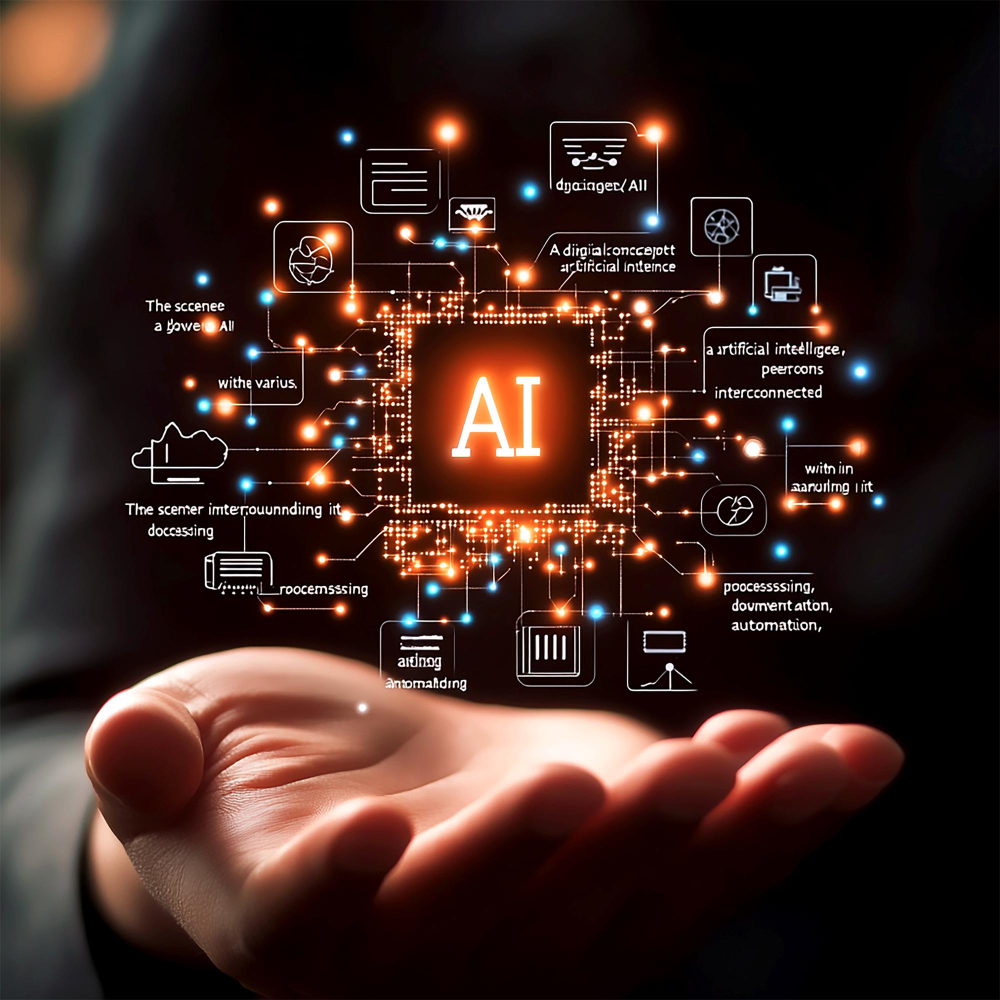Your Strategic Framework
for AI-Powered Digital
Transformation
Embedded Intelligence. Exceptional Outcomes.
The AI Imperative in Transformation
You've heard conversations everywhere. Boards are asking about it, competitors are exploring it, and the media is buzzing. Artificial Intelligence. It's certainly a powerful force, but let's be clear: simply having AI isn't the goal. The real potential lies in how you strategically use AI to fundamentally reshape your business.
Here at ACI Infotech, when we talk about AI-Powered Digital Transformation, we mean something specific. It's moving beyond the buzzwords and proofs-of-concept to embedding intelligence directly into the core fabric of your operations, decisions, and customer interactions. It's not just layering AI on top; it's using AI as the engine to drive a more agile, insightful, and competitive enterprise. Think less about a new tool, and more about a new, smarter way of operating, enabled by intelligence.

So, why is this conversation so critical right now? We're witnessing a unique confluence. Cloud computing provides scalable infrastructure, vast amounts of data are now more accessible than ever before, and AI capabilities have matured significantly. This isn't just futuristic theory anymore; it's practical, deployable technology ready to deliver tangible results at scale.
This moment represents a fundamental shift. We're moving beyond simple digitization – which was often about taking existing processes and making them electronic – towards intelligent transformation. This is about leveraging AI to redefine what's possible, optimize for outcomes you couldn't achieve before, and anticipate future needs proactively.
From our perspective, leading this transformation successfully means focusing on pragmatic application. It's about identifying the specific business challenges you face and applying AI precisely where it can deliver measurable impact – whether that's boosting efficiency, uncovering hidden insights, or creating hyper-personalized experiences. That's the AI-First vision we champion: using intelligence strategically to solve real problems and drive significant business value.
how ACI helps
Why AI is No Longer Optional, It's Foundational
From simple digitization to intelligent transformation isn't just an industry trend; it's a strategic imperative. In today's rapidly evolving global markets, particularly for leaders navigating the complexities of the US and dynamic landscapes in the Middle East and South Asia, leveraging AI is moving decisively from a competitive advantage to a competitive necessity. Why? Because AI fundamentally changes what's possible across your entire value chain. Consider these shifts, enabled by strategically applying AI:
Driving Unprecedented Efficiency
We've long relied on automation, but AI takes this exponentially further. It's not just about automating repetitive tasks; it's about intelligent automation that can handle variability, make nuanced decisions based on data, and optimize complex processes in real-time. Using AI, organizations can achieve levels of operational efficiency and cost optimization that traditional methods simply can't match. It frees up human talent for higher-value work. (Think about this further in our insights on Intelligent Automation vs. Traditional RPA)
Unlocking Predictive Insights for Strategic Decision-Making
The volume and velocity of data today are overwhelming. AI allows you to move beyond reactive reporting to proactive prediction. With AI, leaders can forecast demand with greater accuracy, identify potential risks before they materialize, anticipate market shifts, and uncover hidden opportunities within their own data. This capability transforms decision-making from informed to truly intelligent and forward-looking.
Creating Hyper-Personalized Customer & Employee Experiences
Expectations are higher than ever. Customers want personalized journeys, and employees need intuitive, supportive digital environments. Leveraging AI, companies can analyze vast amounts of behavioral data to deliver truly personalized recommendations, tailor communications, provide proactive support, and create seamless digital interactions that build loyalty and boost productivity. (Explore the impact on experience in our article on How AI is Revolutionizing Customer Experience)
Accelerating Innovation Cycles & New Business Models
The pace of innovation is blistering. AI can significantly speed up R&D, analyze market feedback rapidly, and even help generate novel ideas or product features. By embedding AI, organizations can shorten time-to-market, test new models faster, and even create entirely new AI-driven products or services that disrupt traditional markets.
Gaining Sustainable Competitive Advantage
Ultimately, integrating AI across these areas isn't just about incremental improvements; it's about building a fundamentally smarter, more agile organization. For US companies navigating mature markets, it's about optimizing complex operations to gain an edge. For those in rapidly growing regions like the UAE and India, AI enables leapfrogging competitors, building scalable digital foundations, and responding dynamically to market shifts. It's about creating a durable capability that makes you inherently more competitive.
Simply put, the organizations that are strategically leveraging AI today are the ones defining the future of their industries. It's no longer a question of if you should adopt AI, but how you will strategically embed it to build a more efficient, insightful, and competitive enterprise.
Key Pillars of Successful AI-Powered Transformation
It's easy to focus solely on the exciting AI models themselves – the algorithms, the machine learning techniques. But building a truly intelligent enterprise requires a comprehensive approach. Successful AI-Powered Digital Transformation isn't just about the AI; it's about having the right foundational pillars in place that allow AI to be deployed effectively, ethically, and at scale. Think of it as building the essential infrastructure and strategic capabilities that enable AI to deliver on its promise.
Here are the core pillars we see as non-negotiable for driving impactful AI transformation:
Data Readiness & Strategy
AI models are only as good as the data they learn from. This pillar is about more than just collecting data; it's about treating data as a strategic asset specifically for AI. It involves ensuring data quality, breaking down silos, establishing robust data governance, and making data readily accessible and properly structured for AI workloads. Without an AI-ready data foundation, even the most sophisticated AI will struggle to deliver reliable insights or automate processes effectively. (Deep dive into making your data AI-ready in our article: Building a Truly AI-Ready Data Foundation)
Intelligent Automation:
We touched on this in the previous section. This pillar is about identifying opportunities to embed AI into your core operational workflows and processes. This isn't just about automating simple, repetitive tasks with traditional RPA. Using AI, you can introduce capabilities like intelligent document processing, predictive maintenance scheduling, dynamic pricing adjustments, or automated quality control, handling complexity and variability in ways that drive deeper efficiency and resilience. (Understand the difference: Intelligent Automation vs. Traditional RPA: Why AI is the Game Changer for Efficiency)
AI-Enhanced Customer Journeys
Delivering exceptional customer and employee experiences is paramount. This pillar focuses on how using AI can personalize interactions at scale, anticipate needs, provide proactive support, and create more intuitive digital touchpoints. From sophisticated chatbots that understand intent to predictive engagement models that reach customers at the right moment, AI enables experiences that foster loyalty and drive engagement. (Explore how AI is reshaping experience: The Empathetic Machine? How AI is Revolutionizing Customer Experience & Personalization)
Cloud Foundation
AI workloads are often computationally intensive and require significant storage and flexible processing power. The cloud is typically the essential engine here. This pillar is about leveraging scalable, flexible cloud infrastructure, often including specialized AI/ML services offered by platforms like AWS, Azure, or GCP. A well-architected cloud foundation provides the necessary environment to train, deploy, and scale your AI initiatives efficiently and cost-effectively. (Learn about optimizing your cloud for AI: Cloud is the Engine: Choosing and Optimizing Your Cloud Platform for AI Success)
Secure & Ethical AI Governance
Crucially, as you embed AI deeper into your operations, establishing robust governance is non-negotiable. This pillar addresses the critical need for data privacy (like GDPR or CCPA considerations), algorithmic transparency, bias mitigation, security protocols for AI systems, and overall ethical guidelines for deployment. Building trust in your AI systems, both internally and externally, is fundamental to their long-term success and adoption. This also ties into navigating common challenges in AI implementation. (We delve into navigating these complexities in our insights on: Anticipate & Overcome: Navigating the Top 5 Challenges in AI Transformation)
Successfully navigating AI-Powered Digital Transformation means strategically developing and integrating these five pillars, ensuring they work in concert to support your overall business objectives and allow AI to truly flourish within your organization.
Charting the Course: Your AI Transformation Roadmap
Understanding the destination – an intelligent, competitive enterprise – is crucial. But equally important is charting a clear, pragmatic path to get there. AI-Powered Digital Transformation isn't a single project; it's a journey that typically unfolds through distinct phases. Using AI effectively at each stage requires a thoughtful strategy and disciplined execution. While every organization's path is unique, we often see a successful transformation journey following a trajectory like this:
Assessment & Strategy Definition
Pilot Projects & Proof of Value
Scaling & Integration
Continuous Optimization & Innovation
Role of Partnership
Navigating this journey successfully often highlights the critical Role of Partnership. Having a guide who understands both the strategic landscape and the technical complexities, who can help assess your readiness, define a pragmatic roadmap, select the right pilot projects, and provide the expertise to scale and integrate effectively, can significantly accelerate your progress, and mitigate risk.
Charting this course requires foresight, a willingness to start small and prove value, and a commitment to treating AI as a fundamental, evolving capability within your organization.
Overcoming the Hurdles: Navigating Common Challenges
While the potential of AI-Powered Digital Transformation is immense, successfully realizing it means navigating a landscape that isn't without its obstacles. Leaders we speak with often encounter similar points of friction on their journey. A pragmatic approach means anticipating these challenges and building strategies to effectively mitigate them, rather than being derailed by them.
Here are some of the most common hurdles, and why addressing them strategically is key to success:
-
Data Silos & Quality Issues
We've emphasized data as a critical pillar, but the reality for many organizations is data that's scattered, inconsistent, or simply not clean enough for reliable AI training and deployment. Trying to use AI with poor data is like trying to build a house on shaky ground – it won't stand. Breaking down these silos and implementing robust data quality processes is often the first, significant challenge. (This is foundational, as discussed in: Building a Truly AI-Ready Data Foundation)
-
Legacy System Integration Complexity:
Most large organizations operate with a mix of modern and legacy systems. Integrating new AI capabilities and data pipelines seamlessly into this existing infrastructure can be complex and time-consuming. Ensuring that AI doesn't become another silo, but truly enhances existing workflows, requires careful planning and technical expertise.
-
Talent Gaps & Skill Development
The demand for skilled AI and data science professionals far outstrips supply. Finding, hiring, and retaining the right talent is a challenge. Equally important is upskilling existing teams – not just technical roles, but also business users who need to understand how to interact with and leverage AI-driven insights in their day-to-day work.
-
Change Management & Cultural Adoption
Technology is only part of the equation. Introducing AI-powered processes often means changes to roles, workflows, and decision-making processes. Resistance to change, lack of understanding, or fear of job displacement can hinder adoption. Successfully embedding AI requires a strong focus on communication, training, and fostering a culture that embraces data-driven decision-making and continuous learning.
-
Measuring ROI & Proving Business Value
Quantifying the true return on investment for AI initiatives can be more complex than traditional IT projects. Moving beyond technical metrics to demonstrate tangible business outcomes – be it increased revenue, reduced costs, improved customer satisfaction, or accelerated innovation – requires defining clear KPIs upfront and having the right frameworks in place to track and communicate value effectively. (Understanding how to articulate value is key: Beyond Cost Savings: How to Define and Measure the True ROI of AI Transformation)
-
Security & Ethical Considerations
As AI systems become more powerful and integrated, new security vulnerabilities and ethical dilemmas arise. Bias in algorithms, data privacy concerns, model explainability, and ensuring responsible deployment require careful governance and proactive risk management. Building trust in AI means committing to secure and ethical practices from the outset.
Acknowledging these hurdles isn't about being pessimistic; it's about being realistic and strategic. Using AI successfully means having a plan to anticipate and navigate these complexities. With the right approach – focusing on pragmatic steps, building robust foundations, and potentially leveraging expert partnership – these challenges are not roadblocks, but manageable parts of a successful transformation journey.
AI Transformation in Action
Seeing is believing. While the principles of AI-Powered Digital Transformation apply broadly, how using AI translates into tangible value often becomes clearest when viewed through the lens of specific industries. The challenges and opportunities vary, and the application of AI needs to be tailored to the unique dynamics of each sector. Here are a few brief examples illustrating how pragmatic AI is driving momentous change today:
Manufacturing
Beyond basic factory automation, AI is enabling unprecedented levels of efficiency and predictability. Think predictive maintenance that anticipates equipment failures before they happen, optimizing production schedules, automating quality control inspections using computer vision, or optimizing complex supply chain logistics in real-time. Using AI here means reducing downtime, cutting costs, improving product quality, and making supply chains more resilient.

Healthcare
AI is augmenting human expertise to improve diagnostics, personalize patient care, and streamline operations. Examples include AI-assisted image analysis for faster and more accurate disease detection, identifying patients at risk for certain conditions, optimizing hospital staffing and resource allocation, or powering personalized treatment plans based on vast datasets. Leveraging AI can lead to better patient outcomes and more efficient healthcare delivery.

Financial Services
This sector is a rich ground for AI applications, driven by data. Using AI helps detect fraudulent transactions with greater speed and accuracy, automate customer service interactions via intelligent chatbots, personalize financial advice and product recommendations, assess credit risk more effectively, and optimize trading strategies. AI is enhancing security, improving customer experience, and driving new revenue streams.

Retail
The retail landscape is intensely competitive, and AI is key to understanding and engaging the modern consumer. With AI, retailers can gain hyper-accurate demand forecasting, personalize shopping experiences online and in-store, optimize pricing strategies dynamically, manage inventory more intelligently, and even create personalized marketing campaigns at scale. AI helps create the seamless, relevant experiences customers expect.

These are just a few snapshots, but they illustrate a common thread: when applied pragmatically, using AI is not a distant concept. It's a tool being actively deployed today across diverse industries to solve specific business problems, generate measurable value, and redefine operational excellence and customer engagement.
(For more specific examples and deeper dives into AI use cases, explore our customer success stories here.)
The potential applications are vast, but the focus remains consistent: identify where AI can make a concrete difference for your industry's unique challenges.
The Future Outlook: Continuous Intelligence
If my observations in the previous sections have demonstrated anything, it's that AI-Powered Digital Transformation isn't a one-time event or a project you complete and then forget. It's more accurately described as cultivating a muscle, an evolving capability within your organization. The future isn't just about having AI; it's about building an enterprise that is inherently intelligent and adaptable.
The landscape of AI itself is continuously evolving. Technologies like Generative AI, which can create content (text, images, code), are rapidly moving from theoretical concepts to practical applications, promising to further reshape creativity, communication, and workflow automation. Staying informed about these advancements is part of maintaining your competitive edge.
Ultimately, leading an AI-Powered Digital Transformation is about fostering a culture of continuous intelligence.
It's about creating an organization where intelligence isn't just a feature, but a fundamental operating principle – where decisions are increasingly data-driven, operations are proactively optimized, and innovation is accelerated by the smart application of AI. This is the essence of being an 'AI-First Leader' in practice.
Treating data as a dynamic, living asset that constantly informs decisions.
Embedding AI into processes so they learn and improve over time.
Empowering employees with AI-augmented tools and insights.
Committing to ongoing evaluation, optimization, and responsible scaling of AI initiatives.
Leading Your Transformation with Pragmatic AI

Navigating the complex terrain of modern business demands more than just keeping pace; it requires actively shaping your future. As we've explored, AI-Powered Digital Transformation is no longer a hypothetical future – it is the strategic imperative for leaders aiming to drive unprecedented efficiency, unlock critical insights, and build enduring competitive advantage in both mature US markets and dynamic regions like the Middle East and India.
Successfully embarking on this journey means moving beyond the hype and focusing squarely on pragmatic application. It's about understanding your specific challenges, leveraging AI strategically across your foundational pillars (Data, Cloud, Apps, Automation, Security), navigating the complexities of implementation, and committing to a roadmap that delivers tangible results.


At ACI Infotech, our AI-First vision is centered precisely on this pragmatic reality. We understand that AI isn't a solve-all on its own, but a powerful enabler when integrated intelligently across your digital core. We pride ourselves on being the results-focused partner who helps you embed this intelligence effectively, turning potential into measurable business outcomes.
Ready to transform your ambition into action? Don't let the complexity of AI implementation hold you back. Partner with a team that understands your strategic goals and has the expertise to build and integrate the AI-powered solutions that will define your future.

